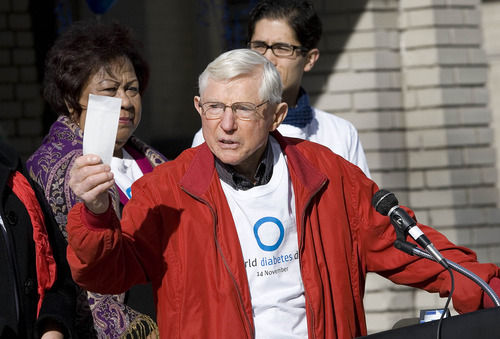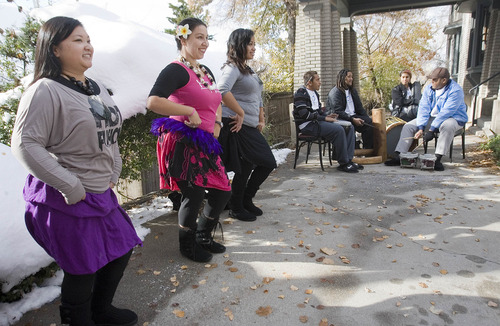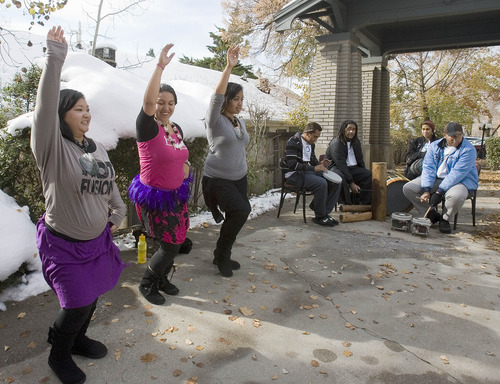This is an archived article that was published on sltrib.com in 2012, and information in the article may be outdated. It is provided only for personal research purposes and may not be reprinted.
On World Diabetes Day, the Juvenile Diabetes Research Foundation, American Diabetes Association and Utah Department of Health pledged to work with communities to help prevent, treat and cure diabetes.
The organizations invited the Malialole drummers, a Pacific Islander group, to perform at their Wednesday press conference, to highlight that 13.7 percent of Utah's Pacific Islander adults have diabetes, double the statewide rate of 6.9 percent. Utah is home to 28,000 Pacific Islanders. Of Pacific Islanders interviewed in Tongan, 44 percent had diabetes.
"It's a lot," said Ivoni Nash, the health program director for the National Tongan American Society. Nash has Type 2 diabetes, and she works to educate her fellow Pacific Islanders about the dangers of the disease and the ways to deal with it.
"I don't want them to go through what I [went] through," Nash said. "I found out I had diabetes [and] I didn't know what to do."
Laura Western, executive director of the Utah chapter of the Juvenile Diabetes Research Foundation, said in a statement after the press conference: "We are at a diabetes crisis breaking point, with more and more children and adults of all ethnicities being diagnosed each year. If current trends continue, 1 in 3 U.S. adults will have diabetes by 2050 and will cost America total $174 billion, or $1 billion in Utah."
The state Office of Health Disparities earlier this month reported encouraging trends in Pacific Islander health. In a 2010 report, health officials said the state's Pacific Islander babies died in infancy at nearly twice the rate of babies statewide. The health disparities office has worked with the community since then, funding efforts from support groups to educational videos.
The office now says obesity during pregnancy has dropped from 39.5 percent to 35 percent among Utah Pacific Islander mothers, and 54 percent of these mothers received early prenatal care, compared to 48.1 percent previously.
The Utah Pacific Islander Health Coalition is celebrating a week of awareness events. A calendar of events is available at http://www.utahpacifichealth.org.
On Thursday, Utahns living with diabetes will share their stories at 6:30 p.m. at the Community Learning Center, 211 South Tooele Blvd., in Tooele. Twenty guests will receive Eli Lilly Diabetes Journey Awards.
The public is invited to the free event, followed by a reception hosted by the Tooele County Diabetes Coalition. It will feature samples of healthy holiday food, recipes, holiday survival tips and displays of new technology for managing diabetes. For details email Eileen DeLeeuw at edeleeuw@utah.gov or call 435-277-2482 or 435-840-0299. —
Recent Salt Lake Tribune stories on diabetes in Utah
Prodded to improve care, Utah doctors look for answers in data: A look at an experiment to improve care for 50,000 Utahns with Type 2 diabetes. —
Details of diabetes
What is it?
Type 1 diabetes results from the body's failure to produce insulin, a hormone key to fueling cells. Type 2 diabetes is a metabolic disorder that occurs when a body doesn't make enough insulin or properly use it.
Who's at risk?
Those who are over age 45, have a family history of diabetes, who are overweight or do not exercise regularly, or who are among many racial and ethic groups, including Latinos, Pacific Islanders and American Indians.
What are the symptoms?
Frequent urination, unusual thirst, extreme hunger, unusual weight loss, or extreme fatigue and irritability.
What can prevent Type 2?
Exercise, eating a healthy diet and maintaining a healthy diet. Learn more:
Utah Department of Health > http://www.health.utah.gov/diabetes
American Diabetes Association > http://www.diabetes.org
Juvenile Diabetes Research Foundation > http://www.jdrf.org —
Diabetes by the numbers
177,000 • Utahns with diabetes
47,000 • Utah adults unaware they have diabetes
Nearly 26 million • American children and adults with diabetes
79 million • American children and adults with pre-diabetes
One in three • Children born today will develop diabetes
$174 billion • Annual cost to treat diabetes in America
$1 billion • Annual direct and indirect health care costs in Utah
Source: Centers for Disease Control and Prevention, Utah Health Department









